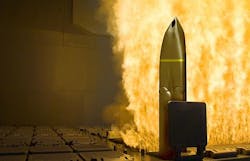Lockheed Martin focuses on firing long-range anti-ship missile (LRASM) from surface ship launchers
NATIONAL HARBOR, Md. – Missile experts at Lockheed Martin Corp. continue to invest in the integration of a long-range anti-ship missile (LRASM) for surface ships like Ticonderoga-class cruisers and Arleigh Burke-class destroyers, which are fitted with the Mk 41 vertical launchers.
The company also has invested its own money in developing a topside launcher to launch the LRASM from ships not fitted with the Mk 41, including big-deck amphibious assault ships, says Scott Callaway, program director for advanced programs and subsonic cruise missiles at Lockheed Martin Missiles and Fire Control in Orlando, Fla. Callaway made his comments in April at the Navy League Sea-Air-Space conference and trade show in National Harbor, Md.
In 2008 the U.S. Defense Advanced Research Projects Agency (DARPA) in Arlington, Va., worked together with the U.S. Office of Naval Research (ONR) to fund Lockheed Martin to modify the company’s joint air-to-surface standoff missile-extended range (JASSM-ER) as a surface-to-surface missile in two variants: a conventional surface-to-surface variant called LRASM A; and a supersonic variant (LRASM B). The “B” work was ended in 2010.
The company added passive emitters and an electro-optic endgame sensor, and made structural changes necessary to launch the LRASM from the Mk 41.
Callaway explains that because of the urgent need to field the LRASM this year, the services decided to field it first on the U.S. Air Force B-1B Lancer strategic bomber, which already is armed with JASSM and JASSM-ER, and therefore will require minimal integration work.
The LRASM will achieve early operational capability (EOC) later this year aboard the B-1B. The missile is scheduled to reach early operational capability for the Navy’s F/A-18E/F Super Hornet fighter/attack aircraft in 2019.
The need remains for a ship-launched LRASM, Callaway says. Lockheed Martin experts considered proposing LRASM in a competition for an over-the-horizon missile for the littoral combat ship (LCS), but withdrew because they determined the LCS could not accommodate the missile.
The company launched the LRASM from the Mk 41 aboard the self-defense test ship Ex-Paul F. Foster -- a decommissioned Spruance-class destroyer -- in 2016 and launched the missile from the company-built topside launcher at White Sands Missile Range last summer. To date the LRASM has had six launches from aircraft and four ship launches.
In addition to the cruisers and destroyers, the company sees a requirement for LRASM for the Navy’s future frigate to meet Navy requirements for its distributed maritime operations surface warfare vision.
Ready to make a purchase? Search the Military & Aerospace Electronics Buyer's Guide for companies, new products, press releases, and videos

